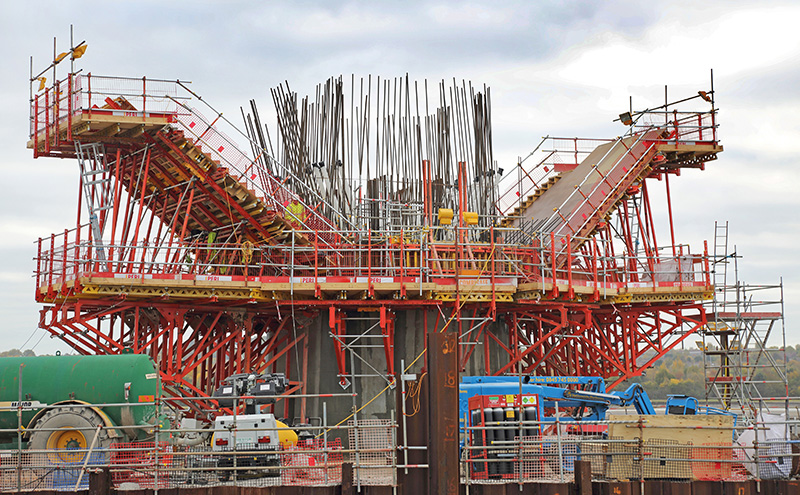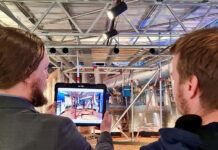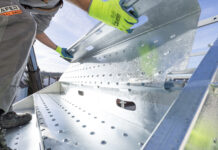
PERI Ltd explains all about the challenging work the supplier of formwork and scaffolder solutions has been undertaking on the Mersey Gateway project
MERSEYSIDE is embracing significant improvements to its transport systems thanks to the landmark construction of the Mersey Gateway. The cable-stayed bridge, which will stretch from Runcorn to Widnes over the River Mersey, will be more than 2,000 metres long and will provide much-needed ease to the traffic congestion across the area.
The major scheme has been long-awaited by the local authority, Halton Borough Council, whose desire to introduce a six-lane toll bridge over the River Mersey was approved in 2010. Designed as an alternative route to the Silver Jubilee Bridge, Mersey Gateway is a commitment to local commuters and is expected to bring in 4,640 new jobs and generate an estimated £61.9 million a year in Gross Value Added by 2030.
Merseylink Civil Contractors joint venture, made up of FCC Construcción S.A., Kier Infrastructure and Overseas Limited and Samsung C&T Corporation, started work in spring 2014. The joint venture called upon the expertise of PERI Ltd to deliver formwork solutions for the ambitious project, after PERI impressed with its design capabilities.
PERI’s involvement has already included the construction of the lower pylons and hammerheads, with the central pier table and three different-sized pylons still to be formed.
One of the challenges common to all bridge construction projects is high wind speeds and the Mersey Gateway is no different. PERI’s unique Automatic Climbing System (ACS), which supports and provides access to formwork systems, can be raised hydraulically without the need of a crane and is supported upon a rail fixed to anchors that are cast into the concrete. The advantage of the hydraulic system for the Mersey Gateway is that it can withstand higher wind speeds than standard cranes meaning windy conditions cause fewer disruptions. Additionally, as crane use is restricted on-site, utilising this system means that other areas of the construction project can fully make use of crane-time.
For the construction of the hammerheads, PERI’s design team utilised its VARIO GT24 formwork with its SB Frames and VARIOKIT system. Unlike a usual application, which would see the SB Frames system used for single face concreting, the Mersey Gateway saw PERI employ the frames as a platform, which meant a unique design was required. The intricate shape of the hammerhead, which included lots of faceted surfaces, meant that cleat boxes (or make up boxes) had to be attached to the flat face of the formwork to form the desired shape.
Once the central hammerhead is completed, the formwork will be removed and PERI’s SB platform will be reused for construction of the pier tables. The pier tables accommodate the installation of the form travellers, meaning construction of the main bridge deck can commence. PERI’s adaptable scaffolding system, PERI UP, will be supported by the SB platform to create a secondary deck at the pier table level.
A significant challenge for the designers of the pier table formwork was the requirement to transfer the high vertical loads into embedded anchors within the lower pylon. As the lower pylon geometry dictated the maximum possible number of anchors, PERI suggested a sequenced construction in layers to avoid the accumulation of vertical forces, ensuring that the loads can be safely supported, making the process more manageable. To ensure a smooth and integrated process, PERI’s team of experts have attended weekly meetings and have also presented at one of the project’s dedicated volunteer visitor centres. By having a consistent presence on site, PERI has been on hand to answer any questions from the contractors and provide product demonstrations if required.
Tony Pearce, project manager at PERI Ltd said, “The Mersey Gateway has proved to be a significant and challenging project to work on. Every part of the formwork that PERI has provided has been specially designed to suit the geometry of the bridge structure, requiring a large amount of in-depth planning for each section of the construction work.
“The challenges of any project are always unique and the Mersey Gateway has proved that PERI has the capabilities to provide the required formwork designs, even if it hasn’t been achieved before in the UK. We are pleased with the progress of the project and look forward to continuing our work at the landmark structure.”
Currently constructing the north, south and central pylons, where the south pylon is set to rise to 125m high, PERI will once again use its hydraulic-lifting ACS system to combat the challenging wind speeds. The Mersey Gateway is expected to open to the public in autumn 2017.











